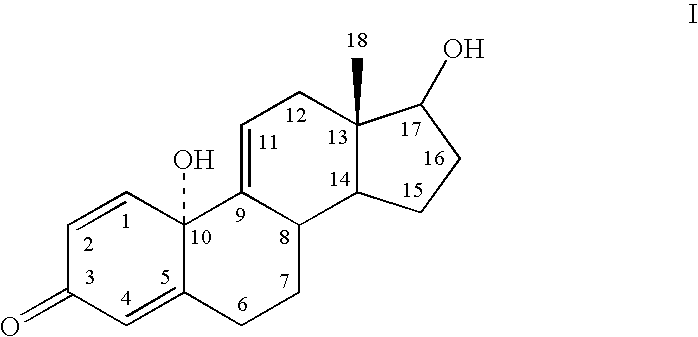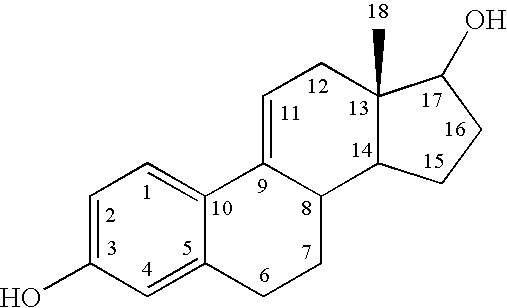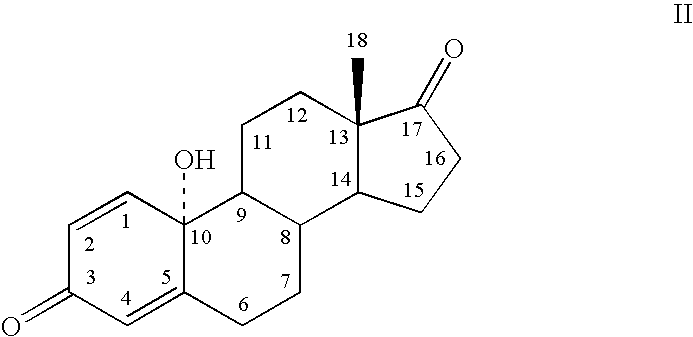Prodrugs for use as ophthalmic agents
a technology of ophthalmic agents and prodrugs, which is applied in the direction of steroids, medical preparations, organic chemistry, etc., can solve the problems of systemic administration of estrogen that eventually reaches the tissue targeted for treatment, is virtually ineffective, and produces undesirable side effects, etc., to achieve the effect of reducing lipid solubility, improving transcorneal penetration, and reducing lipid solubility
- Summary
- Abstract
- Description
- Claims
- Application Information
AI Technical Summary
Benefits of technology
Problems solved by technology
Method used
Image
Examples
example 1
Physicochemical Properties of ZYC1
[0073] Human retinal ganglial cells (RGC) were incubated with glutamate (5 mM), the estrogen analogue 3,17-dihydroxyestra-1,3,5(10),9(11)-tetraene (ZYC1) or combination of glutamate and various concentrations of ZYC1. As illustrated in FIG. 1, glutamate killed about 70% of RGC while the compound of Formula ZYC1 alone had no effect on RGC viability. In the presence of all three concentrations of ZYC1, glutamate killed significantly fewer cells.
[0074] RGC were treated with glutamate (5 mM) in the presence or absence of ZYC1. As illustrated in FIG. 2, this estrogen analogue, ZYC1, reduced the number of RGC killed by glutamate. Where ZYC1 was incubated in the presence of various concentrations of estrogen receptor antagonist, IC1182,780 (ICI) (which at the lowest concentration used, was more than 100-times its IC50), little antagonism of ZYC1 protection of RGC was seen. This data suggests that ZYC1 protects RGC through a non-estrogen receptor mediated m...
example 2
Improved Physicochemical Properties of Steroidal Quinols
[0075] To test the hypothesis that directed modification of an estrogen improves physicochemical properties of transcorneal penetration, estrone was used as a lead compound. The following Table I indicates a very significant drop in lipophilicity of Formula I, Formula II, and Formula III, compared to the parent phenolic A-ring steroids, ZYC1, estrone, and estradiol. The log of the n-octanol / water partitioning coefficient (log P or log D.sub.7.4) is the measure of attraction to lipid phase versus an aqueous phase. Log P is a crucial factor governing passive membrane partitioning, influencing permeability opposite to its effect on solubility (i.e., increasing log P enhances permeability while reducing water solubility). Thus, the results of Table I demonstrate that the lipophilic-hydrophilic balance of Formula I, Formula II, and Formula III are closer to the ideal value for facile transcorneal penetration and favorable bioavailab...
example 3
General Methods for Preparing a Steroidal Quinol
[0077] By way of example, Formula II (estrone quinol; 10.beta.-hydroxyestra-1,4-diene-3,17-dione) was prepared by the following Scheme I: 5
[0078] As understood by the skilled artisan, steroidal quinols according to the present invention may be synthesized using a "one-pot" phenol to quinol transformation. The synthesis method utilizes m-CPBA as an oxidant, dibenzoyl peroxide [(PheCO).sub.2O.sub.2] as a radical initiator and visible-light irradiation that, in refluxing aprotic solvent, produces excellent yields of the quinols of the present invention.
[0079] By way of example, Solaja et al., Tetrahedron Letters, 37:21, 3765-3768 (1996) discloses a "one-pot" method for synthesizing estrone-quinol. Oxidation of estrone to synthesize 10.beta.-hydroxyestra-1,4-diene-3,17-dione is performed by heating a stirred solution of estrone (10.00 g, 37.0 mmol), m-CPBA (22.53 g, 111.0 mmol; 85% Jansen Chimica), and (PheCO).sub.2O.sub.2 (900 mg, 3.70 mm...
PUM
 Login to View More
Login to View More Abstract
Description
Claims
Application Information
 Login to View More
Login to View More - R&D
- Intellectual Property
- Life Sciences
- Materials
- Tech Scout
- Unparalleled Data Quality
- Higher Quality Content
- 60% Fewer Hallucinations
Browse by: Latest US Patents, China's latest patents, Technical Efficacy Thesaurus, Application Domain, Technology Topic, Popular Technical Reports.
© 2025 PatSnap. All rights reserved.Legal|Privacy policy|Modern Slavery Act Transparency Statement|Sitemap|About US| Contact US: help@patsnap.com



